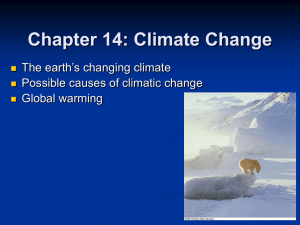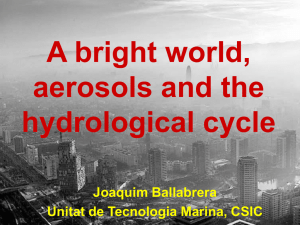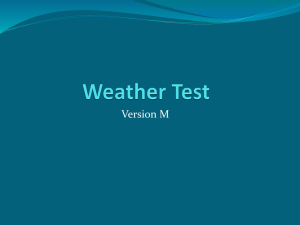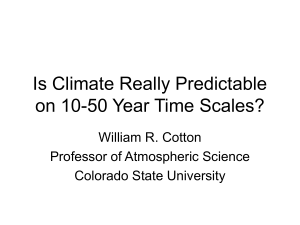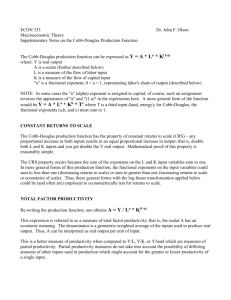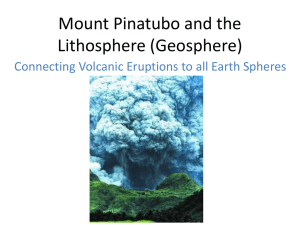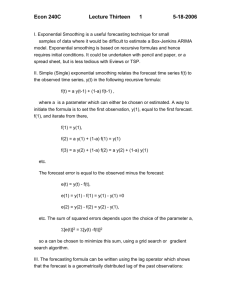Climate Change over Recent Millennia
advertisement
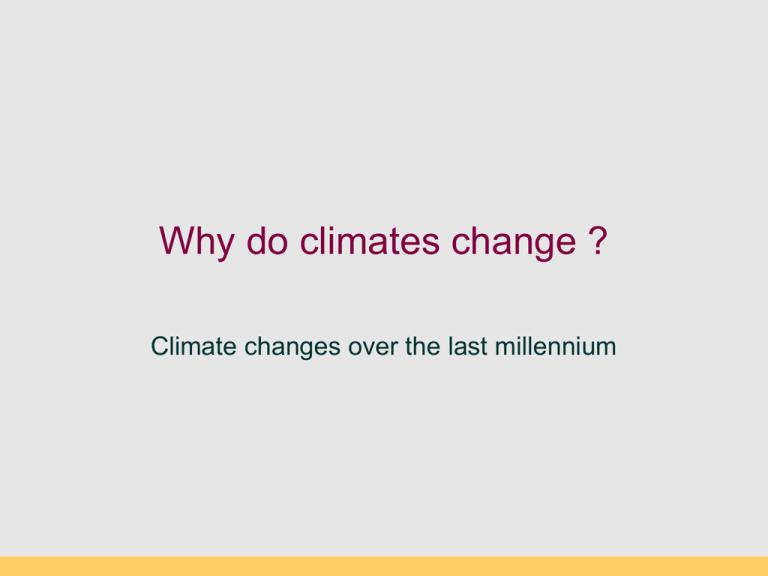
Why do climates change ? Climate changes over the last millennium Take away ideas and understandings • What factors influence climate change over decadal to century timescales? • Solar variability, volcanic eruptions, and greenhouse gases. • How we can quantify their effects ? • Climate history of the last millennium Our first climate model Recall how to calculate Earth’s effective temperature, or the temperature the Earth would be without an atmosphere. The Stefan-Bolzmann equation: Blackbody radiation: I (w/m2) = s T4 Earth’s incoming radiation (a = Earth albedo, or reflectivity) I incoming = (1-a) s Tsun4 Our first climate model Earth incoming radiation (a = Earth albedo, or reflectivity) I incoming = ((1-a) Isolar ) / 4, or ((1-a) s Tsun4 )/ 4 Earth outgoing radiation I outgoing = s Tearth4 a is ~0.3, or 30% e (emissivity) = 1 s = 5.67 x 10-8 W m-2 K-4 Archer Fig. 3.3 (p. 23) Earth’s temperature with no greenhouse effect Teffective = 254.8K (-18°C) At equilibrium, I incoming = I outgoing ((1-a) s Tsun4 ) / 4 = s T4earth Solve for Tearth Eqn. 3.1 in Archer Chapter 3 Surface temperature readings Galileo’s Thermoscope (1500s) Daniel Fahrenheit (1714) closed thermometer First weather stations established ~250 years ago Widespread measurements for last 150 years only. Stockholm Observatory 31 December, 1768: “No one can recall such a mild Autumn: the ground is as green as in the Spring, and today I have picked sufficient young nettles, dandelions, and other herbs to cook green cabbage tomorrow, which is New Year's day.” Many 1000s of stations http://data.giss.nasa.gov/gistemp/ There are only 3 ways to change Earth’s temperature Change input a) b) Solar variability Earth reflectivity (volcanoes) Change output c) Greenhouse gases 1. Volcanoes cool climate, briefly Mt. Tambora - 1815 Mt. Pinatubo - 1994 Volcanic eruption can change albedo by 1% a = ~30% on average Teffective = 254.8K Recalling Iin = (1-a) s T4 ((1-a) s Tsun4 )/ 4 = s T4earth Increase a to 31% New Teffective = 253.9K or -1°C cooler due a volcanic eruption Climate Impacts of Volcanic Eruptions • Volcanoes inject aerosols and particles into the stratosphere which can scatter and/or absorb incoming solar radiation. • Cools the troposphere by up to 0.5-1.0°C for only 24 years. • Warms the Stratosphere by 2-3°C (!) • Short-term but significant impact Mt. Tambora 1815 eruption “Year Without a Summer” “Poverty Year” “1800-and-froze-to-death” Mt. Merapi (Indonesia) tropical volcanoes cool climate most 2. Solar Variability Sunspots, Facular brightening, and Irradiance 30 years of satellite observations: ±1 W/m2 What if the solar radiation changes by +2 W/m2 ? Recalling Isolar = 1365 W/m2 Set Isolar = 1367 W/m2 a = 0.3 Solve for Tearth ((1-a) Isolar)/ 4 = s T4earth ∆T = 0.1°C (Small !) - Sunspots + Sunspot Cycles ~0.1% 1600 1700 1800 1900 Very weak forcing, but significant climate responses to it. 2000 Little Ice Age (1500-1850 AD) LIA Cooling was the result of lower solar radiation and some big volcanic eruptions Little Ice Age (1500-1850) London Frost Fair (1814) 2001 1859 Rhône Glacier Solar Variability • Forcing is very weak (in visible spectrum), only ±0.10.2%, so climate response should be weak. • Climate response is actually quite high - still not sure why. • One possibility is UV part of spectrum - much greater changes (±10%) … suggests that global climate is very sensitive http://data.giss.nasa.gov/gistemp/ How do we estimate past climate change, before there were thermometers “Proxies” - getting temperatures from trees a) Measure ring widths b) Calibrate ring widths Growth Temp. (¡C) 30 25 20 15 10 5 0 0 0.1 0.2 0.3 0.4 0.5 Ring Width (mm) C) Validate and Apply warm T (°C) cool Year AD Temperatures over the last 2,000 years * Date (AD) 2005 Measured CO2 trends since 1958 Atmospheric CO2: Last 250 years Results from the IPCC AR4 report Natural forcing only Natural + Human …most of modern warming is due to humans Natural only Natural + GHG Modeling the climate of the last 1000 years… Climate = Solar Irrad. + Volcanoes + GHG Sum of all forcings (1850-2000) Net = +1.6 W 4 lights per square meter * * * Another way to imagine global warming What global warming really looks like Data source: NASA / GISS Timescales of Natural Climate Variability A. Short time scales (1-2 years): Random weatherrelated variations of turbulent, chaotic atmosphere. B. Interannual (2-8 years): Primarily ENSO and Volcanic eruptions. C. Decadal-to-century scale: - Solar Variability (decades to centuries) Anthropogenic greenhous gas emissions (decades to centuries) What’s in store for the future? Most probable estimate is +2 to +4°C in next 100 years All scenarios warmer. past future Today Global Temperature in 2050 Recent warming is unusual, Future warming is “another world” 2010 * +3°C warming

